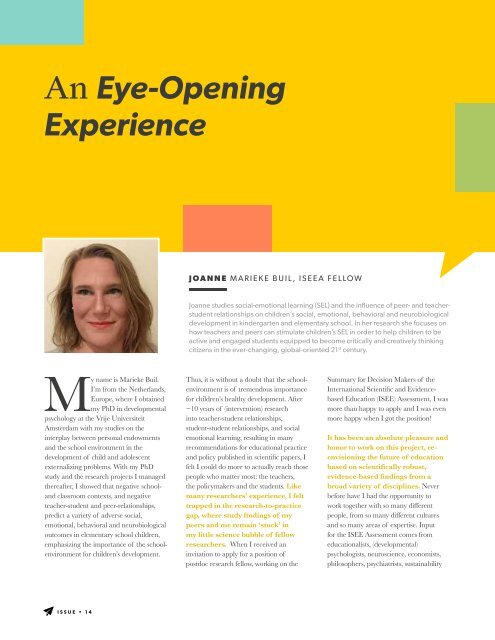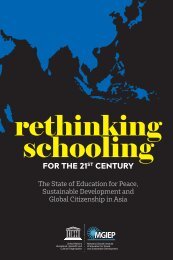The Blue DOT 14 - Multidisciplinary Science & Evidence For Education
Welcome to the 14th edition of the Institute’s flagship publication, The Blue DOT. In this edition, we bring to you news of the International Science and Evidence-based Education Assessment (ISEE Assessment) that the Institute embarked on about 18 months ago. The International Science and Evidence-based Education (ISEE) Assessment contributes to re-envisioning the future of education and feeds into UNESCO's Futures of Education report, today constituting over 250 authors from 70 countries. Read Opinion Pieces by thought-leaders, experts and academics, watch interviews with our advisory board members and explore the learnings of our research fellows while navigating experience of the Multidisciplinary Science & Evidence for Education.
Welcome to the 14th edition of the Institute’s flagship publication, The Blue DOT. In this edition, we bring to you news of the International Science and Evidence-based Education Assessment (ISEE Assessment) that the Institute embarked on about 18 months ago. The International Science and Evidence-based Education (ISEE) Assessment contributes to re-envisioning the future of education and feeds into UNESCO's Futures of Education report, today constituting over 250 authors from 70 countries. Read Opinion Pieces by thought-leaders, experts and academics, watch interviews with our advisory board members and explore the learnings of our research fellows while navigating experience of the Multidisciplinary Science & Evidence for Education.
You also want an ePaper? Increase the reach of your titles
YUMPU automatically turns print PDFs into web optimized ePapers that Google loves.
An Eye-Opening<br />
Experience<br />
JOANNE MARIEKE BUIL, ISEEA FELLOW<br />
Joanne studies social-emotional learning (SEL) and the influence of peer- and teacherstudent<br />
relationships on children’s social, emotional, behavioral and neurobiological<br />
development in kindergarten and elementary school. In her research she focuses on<br />
how teachers and peers can stimulate children’s SEL in order to help children to be<br />
active and engaged students equipped to become critically and creatively thinking<br />
citizens in the ever-changing, global-oriented 21 st century.<br />
My name is Marieke Buil.<br />
I’m from the Netherlands,<br />
Europe, where I obtained<br />
my PhD in developmental<br />
psychology at the Vrije Universiteit<br />
Amsterdam with my studies on the<br />
interplay between personal endowments<br />
and the school environment in the<br />
development of child and adolescent<br />
externalizing problems. With my PhD<br />
study and the research projects I managed<br />
thereafter, I showed that negative schooland<br />
classroom contexts, and negative<br />
teacher-student and peer-relationships,<br />
predict a variety of adverse social,<br />
emotional, behavioral and neurobiological<br />
outcomes in elementary school children,<br />
emphasizing the importance of the schoolenvironment<br />
for children’s development.<br />
Thus, it is without a doubt that the schoolenvironment<br />
is of tremendous importance<br />
for children’s healthy development. After<br />
~10 years of (intervention) research<br />
into teacher-student relationships,<br />
student-student relationships, and social<br />
emotional learning, resulting in many<br />
recommendations for educational practice<br />
and policy published in scientific papers, I<br />
felt I could do more to actually reach those<br />
people who matter most: the teachers,<br />
the policymakers and the students. Like<br />
many researchers’ experience, I felt<br />
trapped in the research-to-practice<br />
gap, where study findings of my<br />
peers and me remain ‘stuck’ in<br />
my little science bubble of fellow<br />
researchers. When I received an<br />
invitation to apply for a position of<br />
postdoc research fellow, working on the<br />
Summary for Decision Makers of the<br />
International Scientific and <strong>Evidence</strong>based<br />
<strong>Education</strong> (ISEE) Assessment, I was<br />
more than happy to apply and I was even<br />
more happy when I got the position!<br />
It has been an absolute pleasure and<br />
honor to work on this project, reenvisioning<br />
the future of education<br />
based on scientifically robust,<br />
evidence-based findings from a<br />
broad variety of disciplines. Never<br />
before have I had the opportunity to<br />
work together with so many different<br />
people, from so many different cultures<br />
and so many areas of expertise. Input<br />
for the ISEE Assessment comes from<br />
educationalists, (developmental)<br />
psychologists, neuroscience, economists,<br />
philosophers, psychiatrists, sustainability<br />
Like many researchers’ experience, I felt<br />
trapped in the research-to-practice gap,<br />
where study findings of my peers and me<br />
remain ‘stuck’ in my little science bubble of<br />
fellow researchers.<br />
and environmental scientists and many more scientific areas. I<br />
have the pleasure to collaborate with all these researchers from<br />
various fields, but also with international government advisors,<br />
entrepreneurs, jurists, politicians, engineers and more. Where I<br />
thought before that I was doing ‘interdisciplinary science’ when<br />
working together with e.g., a medical doctor and someone from the<br />
local government, this project by UNESCO MGIEP showed me<br />
what true international, interdisciplinary collaboration means.<br />
It’s an eye-opener and worthwhile to experience that<br />
people from various backgrounds can have wildly<br />
different opinions about and insights in what for example<br />
‘education’, ‘curriculum’, ‘assessment’, ‘flourishing’, and<br />
‘learning’ entails.<br />
Although at times challenging, it has been and is a very important<br />
learning opportunity for me to learn to understand ‘education<br />
and learning’ from all these different angles and to come to a<br />
shared meaning, vision and mission and I’m very happy that I can<br />
collaborate in this project!<br />
ISSUE • <strong>14</strong><br />
6 5

















